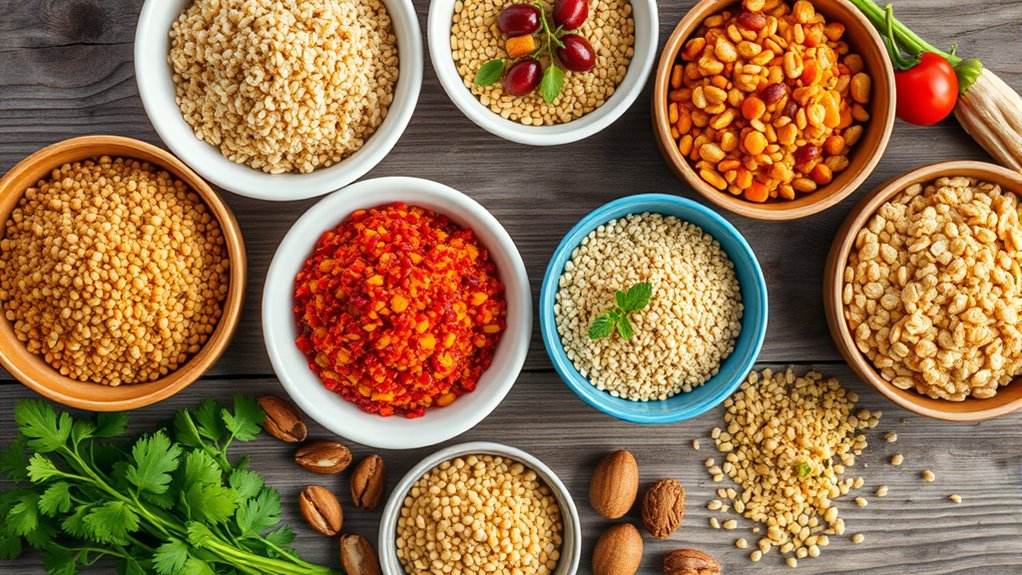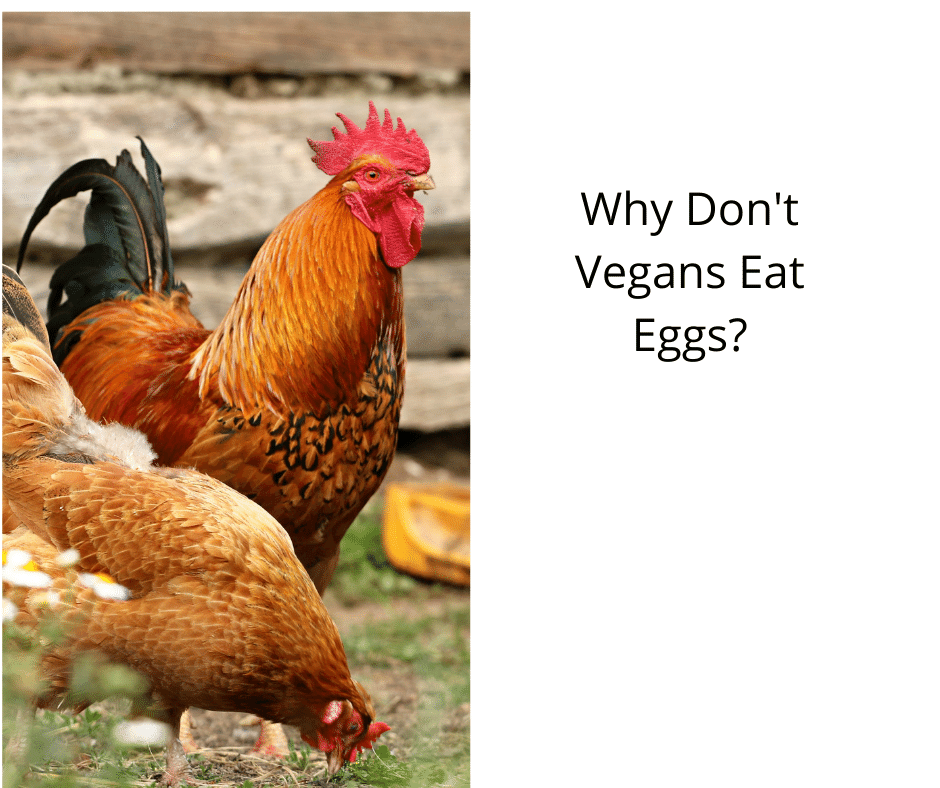Vegan ancient grains like quinoa, amaranth, and millet are nutrient-dense superfoods with rich histories, perfect for boosting your diet. They provide a variety of nutrients, such as complete proteins, fiber, magnesium, and antioxidants, supporting your health while adding flavor and texture to meals. These grains are versatile and easy to cook into salads, porridges, or side dishes, inspiring creative, wholesome dishes. Keep exploring to uncover delicious recipes and tips for incorporating these nutrient-packed grains into your plant-based lifestyle.
Key Takeaways
- Ancient grains like quinoa, amaranth, and millet provide essential nutrients such as complete proteins, fiber, vitamins, and minerals suitable for vegan diets.
- They are culturally significant, versatile, and easy to incorporate into various vegan recipes like salads, porridges, and side dishes.
- Cultivating ancient grains supports sustainable farming practices with minimal chemical use and resilience to harsh climates.
- Their nutty flavors and chewy textures enhance culinary creativity, adding depth and variety to plant-based meals.
- Minimal processing preserves their nutritional integrity, making them wholesome ingredients for nutritious vegan dishes.

Ancient grains have gained popularity among vegans for their rich nutritional profiles and versatility in plant-based diets. These grains, often overlooked in modern agriculture, are making a comeback thanks to their health benefits and cultural significance. When you explore the world of ancient grains, you’ll find that understanding their origins and how they’re cultivated can deepen your appreciation for these superfoods. Grain cultivation of ancient grain varieties involves traditional farming methods that often rely on sustainable practices, making them an eco-friendly choice. Many of these grains, such as quinoa, amaranth, and millet, have been cultivated for thousands of years, passed down through generations in various regions around the world. Their resilience to harsh climates and minimal need for chemical inputs make them an attractive option for conscious eaters like you who want to support sustainable agriculture. Additionally, learning about the sound vibrations involved in traditional farming practices can provide insight into the holistic approach used in cultivating these grains. You’ll notice that each ancient grain variety offers a unique set of nutrients, making them ideal for a balanced vegan diet. For instance, quinoa is a complete protein containing all nine essential amino acids, which is rare among plant foods. Amaranth is packed with fiber, magnesium, and manganese, promoting digestion and overall metabolic health. Millet provides a good source of magnesium and antioxidants, aiding in inflammation reduction. Incorporating these grains into your meals not only boosts your nutrient intake but also introduces diversity to your diet, which is fundamental for meeting all your nutritional needs. Cooking with ancient grain varieties is straightforward once you understand their specific requirements. Many of these grains are versatile enough to serve as a base for salads, porridges, or side dishes. For example, you can prepare a hearty quinoa salad with fresh vegetables and herbs, or cook millet as a creamy porridge topped with fruits and nuts. Because these grains are minimally processed, they retain much of their nutritional integrity, making your meals wholesome and satisfying. Additionally, their nutty flavors and chewy textures add depth to various dishes, allowing you to experiment creatively in the kitchen.
Frequently Asked Questions
Are Vegan Ancient Grains Suitable for Gluten-Sensitive Individuals?
If you’re gluten-sensitive, vegan ancient grains might still be an option, but it depends on the specific grain. Many ancient grains, like quinoa and millet, have low or no gluten content, making them suitable as alternative grains. However, some, like spelt and kamut, contain gluten. Always verify labels and consult your healthcare provider to guarantee the grain you choose aligns with your gluten sensitivity needs.
How Do Ancient Grains Compare Nutritionally to Modern Grains?
Imagine switching from white rice to quinoa; you’ll notice quinoa offers more protein and fiber. Ancient grains like spelt and kamut tend to have higher nutritional content, including essential vitamins and minerals, compared to modern grains. They also promote grain diversity, which supports a balanced diet. Overall, ancient grains often provide richer nutrient profiles, making them a healthier choice for those seeking variety and better nutrition.
Can Ancient Grains Be Sprouted for Increased Nutrient Absorption?
Yes, you can sprout ancient grains to boost nutrient bioavailability. Sprouting benefits include breaking down anti-nutrients, which makes minerals more accessible and enhances digestion. When you soak and germinate grains like quinoa, millet, or buckwheat, you reveal more vitamins and improve overall nutritional value. Incorporate sprouted ancient grains into your meals for a nutrient-dense boost, enjoying tastier, more digestible, and healthful dishes.
What Are the Best Storage Methods for Keeping Ancient Grains Fresh?
You can keep your ancient grains fresher than a dew-kissed morning by storing them in airtight containers, which lock out moisture and pests like a fortress. Place these containers in a cool, dark spot—your pantry or cupboard—to prevent spoilage and maintain flavor. Avoid sunlight and heat, or your grains might turn stale faster than a fleeting dream. With this method, your grains stay fresh and ready for your next culinary adventure!
Are There Any Known Allergies Associated With Specific Ancient Grains?
You should be aware that some ancient grains, like spelt and kamut, contain gluten, which can trigger issues if you’re gluten intolerant. Additionally, if you have seed allergies, you might react to grains like quinoa and amaranth, which are technically seeds. Always check labels and consult with a healthcare professional if you’re unsure about potential allergies, especially when trying a new grain for the first time.
Conclusion
Embracing vegan ancient grains is like planting seeds of nourishment that grow into a garden of energy. Each bite symbolizes a connection to centuries of tradition, reminding you that your choices hold the power to cultivate health and sustainability. As these grains nourish your body, they also symbolize hope—an enduring link between past and future. By choosing them, you’re not just fueling yourself; you’re nurturing a legacy of mindful living and vibrant well-being.
Ilana has been a vegan for over 10 years. She originally made the switch for health reasons, but soon found herself becoming more and more passionate about the ethical and environmental implications of a vegan lifestyle. Ilana is the author of The Graceful Kitchen, a blog all about veganism. She loves to cook up delicious and nutritious vegan meals, and share her recipes with others who are interested in leading a cruelty-free life. Ilana is also a strong advocate for using whole foods as the foundation of a healthy diet, and believes that going vegan is one of the best ways to achieve this.















